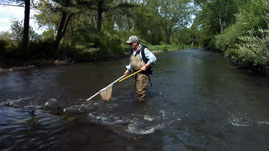Teachers' Domain - Digital Media for the Classroom and Professional Development
User: Preview

Source: Produced by the Wisconsin Educational Communications Board.
Meet John Lyons, a fisheries research biologist with the Wisconsin Department of Natural Resources. He describes why trout are important indicators of stream health and climate change impacts in Wisconsin. This video, produced by the Wisconsin Educational Communications Board, also explores uncertainty in climate change modeling and the range of possibilities for temperature and precipitation that may result for different regions of Wisconsin.
When scientists use the word "uncertainty," they mean something slightly different than just not being sure about something. When it comes to climate science, uncertainty has to do with a range of possibilities that could happen in the future, depending on whether humans decrease greenhouse gas emissions, and taking into account that climate systems are variable and difficult to predict. By looking at data from the past, scientists attempt to predict the future using statistical modeling. Researchers at the University of Wisconsin – Madison have "downscaled" global climate models, which means they have inserted local historical climate data to generate climate change predictions for regions across the state. The downscaling of these global climate models produces a range of possibilities based on the different human response scenarios incorporated into the models—in other words, based on the extent to which humans reduce greenhouse gas emissions. This range of possibilities leads to a level of uncertainty about the future.
For example, the results of the model using the highest level of anticipated greenhouse gas emissions suggest a 6°F (3.3°C) increase in the average annual surface air temperatures for southwest Wisconsin. On the other hand, the model using the lowest level of anticipated emissions resulted in a 4.5°F (2.5°C) increase. The difference between these scenarios seems small, but it can mean the difference between life and death for some species. Animals and plants are adapted to fill certain niches within the environment. Many species are adapted to a certain range of temperatures, and outside of that range they become stressed and potentially die. If a stream containing brook trout, a cold-water species, is already on the brink of its temperature range, an extra 1.5°F could mean the extinction of this species in the region. Further uncertainty can be added to this example by the fact that a variety of factors influence stream water temperature, including ground water inflow rates, tree cover, and landscape variables, each of which adds additional uncertainly to the computational scenarios. Each stream has a unique combination of these variables, rendering them either more or less susceptible to rising air temperatures.
Additional uncertainty comes from the inherent variability of climate from one place to another. For instance, we know the amount of rainfall can vary from one county to another, and so the predicted changes in future rainfall are similarly patchy, with some areas likely becoming wetter and others drier. This spatial variation has been evident in recent years, as southern Wisconsin experiences severe flooding while northern Wisconsin suffers from drought.
Analyzing historical trends in climate data can help us understand past climate trends and variability, but climate models based on these data from the past inevitably produce uncertainty because there is no analog to our current situation. The rate of climate change today is far faster than it has ever been in the history of Earth. Scientists researching global climate change are, in essence, trying to reduce the level of uncertainty about our future climate so that our societies can make informed decisions to adapt to and mitigate the impacts.
Here are suggested ways to engage students with this video and with activities related to this topic.
 Loading Standards
Loading Standards